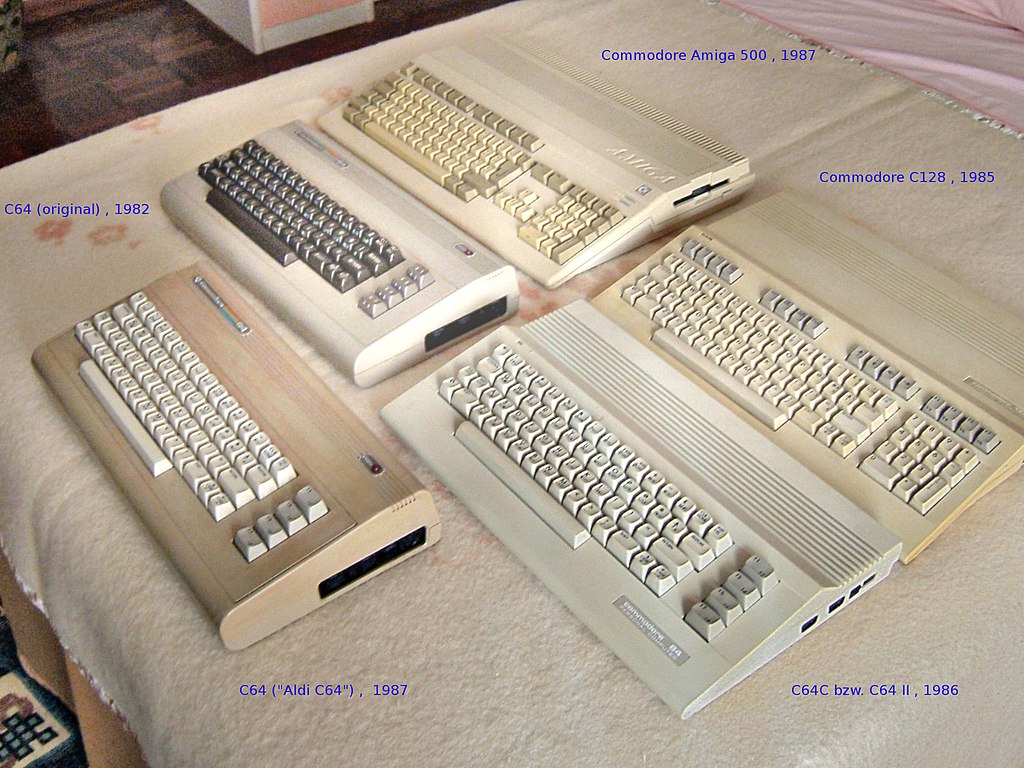Repairing Commodore and Amiga computers in the 1990s
by johna | August 5, 2022 | Retro Computing Computers & Internet
Since I am on the subject of retro computing after my last post about The 8-Bit Guy YouTube channel, I thought I might write about my experiences working in a Commodore repair centre in the 1990s and some of the common problems we used to deal with.
Commodore 64 jobs were dwindling by this time but we did see still many. Various chips failed although I don't recall which ones except for RAM chips, but I do recall that the power supplies often played up intermittently often damaging one or more chips when they failed. Standard practise was to add a zener diode after the repair to prevent any future damage.
We cleaned disk drive heads and did head alignments.
We saw the odd PET that was still in use and a small amount of VIC-20s, but I don't recall many C16 or Plus/4 models. There was an occasional C128 or 128D and, vary rarely, a SX-64 (portable).
The Amiga was in full swing by this time so we saw many of these in for repair and upgrades.
Common problems with the A500 and probably other models was that the PLCC chips came loose so we used to reseat them after giving the socket a clean.
We also cleaned plenty of 3.5-inch floppy drive heads and fixed mice that needed cleaning or had broken cables. I think power supplies were another common problem, although I don't recall what the usual faults were.
We upgraded many to the "fat" Agnes and changed many Kickstart ROMs from 1.2 to 1.3. We often soldered the 1.2 and 1.3 ROMs together and added a switch so that both versions could be used.
A2000s suffered from leaking NiCad batteries that ate away at the circuit board tracks.
The A4000s had a common problem where some surface-mount capacitors were installed backwards on the processor board and often failed and sometimes leaked, causing damage to the board.
1084 monitors were a very common sight and had a few common problems. The power switches were a common failure (similar to other Commodore monitors) but a generic replacement was available.
They also suffered from bad solder joints on the flyback joints. This was usually easy to identify as the picture would disappear intermittently.
The flyback transformers were also a common failure. If there is no picture and a high-pitched whistle sound, chances are it would need a new flyback transformer.
From memory, the Commodore IBM compatible PCs didn't have many hardware problems but I do recall that many of the PC monitors suffered from bad solder joints that caused colours to drop out.
Once Commodore ceased business, we still saw many systems in for repair for several years afterwards. We had our own stock of some parts and were able to buy parts from a source that had bought up a lot of parts when the company was liquidated.

Commodore 64 jobs were dwindling by this time but we did see still many. Various chips failed although I don't recall which ones except for RAM chips, but I do recall that the power supplies often played up intermittently often damaging one or more chips when they failed. Standard practise was to add a zener diode after the repair to prevent any future damage.
We cleaned disk drive heads and did head alignments.
We saw the odd PET that was still in use and a small amount of VIC-20s, but I don't recall many C16 or Plus/4 models. There was an occasional C128 or 128D and, vary rarely, a SX-64 (portable).
The Amiga was in full swing by this time so we saw many of these in for repair and upgrades.
Common problems with the A500 and probably other models was that the PLCC chips came loose so we used to reseat them after giving the socket a clean.
We also cleaned plenty of 3.5-inch floppy drive heads and fixed mice that needed cleaning or had broken cables. I think power supplies were another common problem, although I don't recall what the usual faults were.
We upgraded many to the "fat" Agnes and changed many Kickstart ROMs from 1.2 to 1.3. We often soldered the 1.2 and 1.3 ROMs together and added a switch so that both versions could be used.
A2000s suffered from leaking NiCad batteries that ate away at the circuit board tracks.
The A4000s had a common problem where some surface-mount capacitors were installed backwards on the processor board and often failed and sometimes leaked, causing damage to the board.
1084 monitors were a very common sight and had a few common problems. The power switches were a common failure (similar to other Commodore monitors) but a generic replacement was available.
They also suffered from bad solder joints on the flyback joints. This was usually easy to identify as the picture would disappear intermittently.
The flyback transformers were also a common failure. If there is no picture and a high-pitched whistle sound, chances are it would need a new flyback transformer.
From memory, the Commodore IBM compatible PCs didn't have many hardware problems but I do recall that many of the PC monitors suffered from bad solder joints that caused colours to drop out.
Once Commodore ceased business, we still saw many systems in for repair for several years afterwards. We had our own stock of some parts and were able to buy parts from a source that had bought up a lot of parts when the company was liquidated.

Related Posts
My favourite Commodore 64 and Amiga games
by johna | August 14, 2022
My favourite games from the 1980s and 1990s.
C64 OS is one of the most amazing programming projects
by johna | August 13, 2022
C64 OS is an amazing character-based UI and OS for the now 40-year-old Commodore 64.



Comments
There are no comments yet. Be the first to leave a comment!